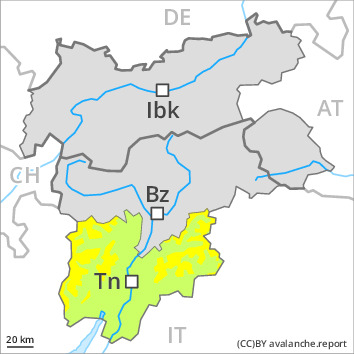
Danger level
 | 2200m |
|  |
|  | ||||
|  |
|  |

Wind slabs above approximately 2200 m.
As a consequence of a moderate to strong wind from northerly directions, sometimes avalanche prone wind slabs formed above approximately 2200 m. These can be released in isolated cases. In particular transitions from a shallow to a deep snowpack are unfavourable. Avalanche prone locations are to be found in particular in gullies and bowls, and behind abrupt changes in the terrain and in shady places that are protected from the wind.
Avalanches can additionally in very isolated cases be released in the old snowpack by small loads, in particular on very steep slopes. In very isolated cases avalanches can also reach large size. Isolated whumpfing sounds can indicate the danger. Very steep, little used shady slopes are to be evaluated with care and prudence.
Snowpack
dp.6: cold, loose snow and wind
dp.7: snow-poor zones in snow-rich surrounding
Faceted weak layers exist in the centre of the snowpack, in particular on shady slopes above the tree line, as well as on sunny slopes in high Alpine regions. In areas where the snow cover is rather shallow the likelihood of avalanches is higher.
In the vicinity of peaks the wind will be moderate to strong. The fresh wind slabs are poorly bonded with the old snowpack in particular on steep shady slopes.
As a consequence of the moderate to strong northwesterly wind, fresh snow drift accumulations will form. Snow depths vary greatly above the tree line, depending on the infuence of the wind. On steep sunny slopes less snow than usual is lying.
Below the tree line, shady places that are protected from the wind: The snowpack is faceted; its surface is loosely bonded and consists of surface hoar.
Tendency
Some snow will fall in particular in the south.

